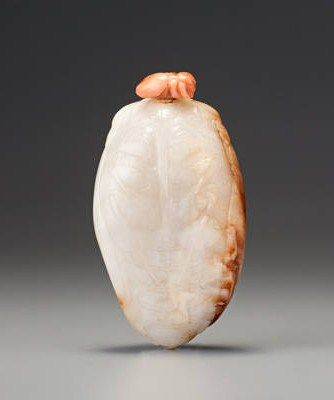27 novembre 2011
Treasury 1, no. 59: A white and russet nephrite 'archaistic cicada' snuff bottle, 1700-1820.
Treasury 1, no. 59: A white and russet nephrite 'archaistic cicada' snuff bottle, 1700-1820. Photo Bonhams
Nephrite of pebble material; well hollowed and carved in the form of a cicada, the surface decorated with archaistic motifs, including birds on each wing. Length: 6.29 cm. Mouth: 0.43 cm. Stopper: coral, carved in the form of a cicada. Estimate: HK$115,000 - 200,000, US$ 15,000 - 26,000
Condition: two miniscule chips to the lip; natural flaws worked into the design following the line of the wing; small chip on the underside of the hind leg of the cicada
Provenance: Robert Hall (1984)
Condition: two miniscule chips to the lip; natural flaws worked into the design following the line of the wing; small chip on the underside of the hind leg of the cicada
Provenance: Robert Hall (1984)
白玉帶皮仿古蟬形鼻煙壺
Published: Kleiner 1987, no. 58
Treasury 1, no. 59
The Mary and George Bloch Collection
Published: Kleiner 1987, no. 58
Treasury 1, no. 59
The Mary and George Bloch Collection
Exhibited: Sydney L. Moss Ltd., London, October 1987
Creditanstalt, Vienna, May–June 1993
Because of its ancient origins in Chinese art, the cicada was frequently depicted during the Qing dynasty with archaistic elements, even if only hinted at in small, comma-like motifs taken from ancient bronze and jade decoration and confined to the head and upper back of the insect. Snuff bottles of cicada form are reasonably common and range from the almost entirely realistic to archaistic abstractions.
Of all the cicada-form snuff bottles known, this is the epitome of the application of archaism to a realistic subject. It is also one of the finest and most convincingly carved insect sculptures in the entire field of Chinese snuff bottles. The use of a natural pebble of nephrite has dictated the form to some extent, which is delightfully eccentric for a cicada-form snuff bottle. With complete and wholly confident control of the medium, the artist has carved the underside of the insect in as realistic a manner as can be found on such bottles. The lower part and the upper front of the head have also been realistically depicted. The rest of the upper portion, including the back of the head, the upper back and the wings are all carved with formalized, archaistic motifs, which include the very rare feature of complete birds on each wing replacing the usual formalized depiction of the skeletal structure of the wings. One other example is known with a similar feature, although the illustration does not allow distinction between archaic birds and the alternative kui or even chi dragons. It is in white nephrite and, because its form was not dictated to any degree by the original pebble material, it is less eccentrically shaped (JICSBS, Autumn 1988, p. 24, fig. 2, previously sold by Sotheby's, London, 6 June 1988, lot 64). These birds are taken from bronze decoration of the Zhou dynasty and add immensely, not only to the visual charm of the bottle but also to its symbolism, linking a purely Qing art-form with long-established symbolism and a powerful reference to the material culture of a past golden age.
The stopper is a delightful crowning touch to a masterly bottle. It is of softly coloured and attractively striated coral and it is also carved in the form of a cicada, although entirely realistically. Among stoppers, it is a masterpiece in its own right.
Creditanstalt, Vienna, May–June 1993
Because of its ancient origins in Chinese art, the cicada was frequently depicted during the Qing dynasty with archaistic elements, even if only hinted at in small, comma-like motifs taken from ancient bronze and jade decoration and confined to the head and upper back of the insect. Snuff bottles of cicada form are reasonably common and range from the almost entirely realistic to archaistic abstractions.
Of all the cicada-form snuff bottles known, this is the epitome of the application of archaism to a realistic subject. It is also one of the finest and most convincingly carved insect sculptures in the entire field of Chinese snuff bottles. The use of a natural pebble of nephrite has dictated the form to some extent, which is delightfully eccentric for a cicada-form snuff bottle. With complete and wholly confident control of the medium, the artist has carved the underside of the insect in as realistic a manner as can be found on such bottles. The lower part and the upper front of the head have also been realistically depicted. The rest of the upper portion, including the back of the head, the upper back and the wings are all carved with formalized, archaistic motifs, which include the very rare feature of complete birds on each wing replacing the usual formalized depiction of the skeletal structure of the wings. One other example is known with a similar feature, although the illustration does not allow distinction between archaic birds and the alternative kui or even chi dragons. It is in white nephrite and, because its form was not dictated to any degree by the original pebble material, it is less eccentrically shaped (JICSBS, Autumn 1988, p. 24, fig. 2, previously sold by Sotheby's, London, 6 June 1988, lot 64). These birds are taken from bronze decoration of the Zhou dynasty and add immensely, not only to the visual charm of the bottle but also to its symbolism, linking a purely Qing art-form with long-established symbolism and a powerful reference to the material culture of a past golden age.
The stopper is a delightful crowning touch to a masterly bottle. It is of softly coloured and attractively striated coral and it is also carved in the form of a cicada, although entirely realistically. Among stoppers, it is a masterpiece in its own right.
Bonhams. FINE CHINESE ART, 28 Nov 2011. Hong Kong www.bonhams.com
Publicité
Publicité
Commentaires

/https%3A%2F%2Fprofilepics.canalblog.com%2Fprofilepics%2F1%2F0%2F100183.jpg)
/https%3A%2F%2Fstorage.canalblog.com%2F03%2F02%2F119589%2F96711876_o.jpg)
/https%3A%2F%2Fstorage.canalblog.com%2F11%2F31%2F119589%2F94773502_o.jpg)
/https%3A%2F%2Fstorage.canalblog.com%2F20%2F83%2F119589%2F94772815_o.jpg)
/https%3A%2F%2Fstorage.canalblog.com%2F26%2F72%2F119589%2F75604929_o.jpg)
/https%3A%2F%2Fstorage.canalblog.com%2F59%2F60%2F119589%2F26458628_o.jpg)








/image%2F1371349%2F20240411%2Fob_ba627e_telechargement-1.png)
/http%3A%2F%2Fstorage.canalblog.com%2F55%2F60%2F119589%2F126938720_o.jpg)
/http%3A%2F%2Fstorage.canalblog.com%2F07%2F97%2F119589%2F126599594_o.jpg)
/http%3A%2F%2Fstorage.canalblog.com%2F78%2F59%2F119589%2F126047938_o.jpg)